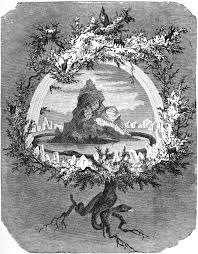My father also had a great love of trees and when we were kids, he planted three young poplars in the back garden of the council house he was given when he was demobbed. I believe that they still grace, or should I say overshadow, the house to this day. When he moved from St Helen's to be landlord of a 4th Century coaching inn, in the late 1960s, he planted a weeping willow in an area of the garden that was previously occupied by geese and nettles, then designed a beer garden around it. Another tree that outlived him. I know that he would be very proud - as I am of him. He was the first person I knew who offset his own carbon footprint. My hero.
I often use trees or metaphors around trees in my poetry. Trees captivate me. I recently watched a TV documentary that explained how the fungi that grow on tree roots not only feed minerals extracted from dying leaves back into the trees that they fall from but that they interlink underground and communicate with each other. Isn't that fascinating.
Trees have profound roles in worlds both real and fictional. With their majestic bark, lush laid-out branches and billowing cloud of leaves, humans are drawn to them in deep fascination. This magic is embodied in the marvelous account of the Norse World Tree. According to Norse mythology, the entire world is in fact a tree, called Yggdrasil (“igg-dreh-sell”) located at the center of the universe.
According to the legends, Yggdrasil is a gargantuan living ash tree with branches extending above the heavens and a trunk strongly latched into the ground by three great roots. Here, the gods assemble and meet, seek sustenance from its life-giving branches, and watch over the worlds. Radiating from this center span the nine realms of existence, including Asgard, the home of the gods and the hall of Valhalla, and Midgard, the land of the human mortals. An anonymous eagle sits in the top of its branches in constant conflict with an evil serpent, Nidhogg, who tries to unbalance the tree by chewing through one of its roots.
This ever-green ash tree has been found in various texts, including the famous Prose Edda and the Poetic Edda. The latter is an unnamed collection of anonymous poems which contains the text from Icelandic manuscript Codex Regius, the prime source of Norse mythology. The Prose Edda is a collection of books written by 13th century Icelandic historian Snorri Sturluson. In Gylfaginning, one of the books of the Prose Edda, Yggdrasil is clearly described in Chapter 15:

The Downfall of Adam
We had to let that forest rot and fall,
We had to fell the ancient trees,
opening the canopy of shrouded inequality.
We lived in darkness. following a time-worn pathway,
carved for us by Adam's foot.
This is new forest.
A place where sunlight seeps into the shadows,
where we can strive and challenge,
find our individual piece of sky.
Now tender shoots stand taller,
grow stronger under Eve's watchful eye.
Thanks for reading. Adele
Email ThisBlogThis!Share to TwitterShare to Facebook
Reactions:
